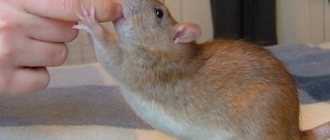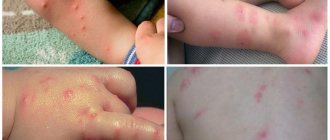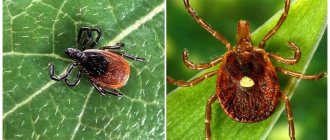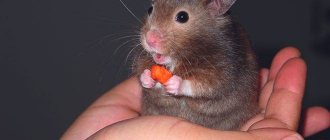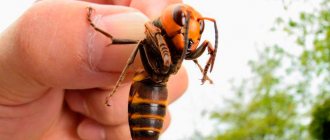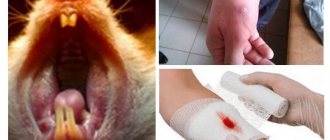Around 100,000 rat attacks on people are recorded annually around the world. Moreover, according to official statistics, only one rat bite out of 36 becomes known to health authorities and is included in these very statistics. That is, in fact, every year up to 3.5 million people around the world become victims of rat attacks, a significant part of which are children.
Perhaps the first thing to keep in mind is that if you or your child are bitten by a rat, there is no need to panic: it is not fatal, and the likelihood that a bite will cause infection with a dangerous disease, although possible, is very small. In addition, with the help of fairly simple actions, the risk of developing undesirable consequences after a rat bite can be minimized - we will talk about this in more detail below.
On a note
However, even without infection of the wound, a rat can cause serious injury with its sharp teeth. There are cases when these animals bit off a piece of a person’s ear and even broke a finger (crack in the bone). And in especially impressionable victims, a sudden rat attack can cause the development of phobias and various nervous disorders that can accompany a person for years, sometimes for the rest of his life. This is especially true for children.
So, let's see what needs to be done immediately if a rat bites, that is, literally in the first minutes after the rodent attack - the possible consequences of the bite largely depend on how correctly and quickly the appropriate actions are taken...
First actions after a rat bite
The first thing to do after a rat bite is to wash the wound with water and treat it with any highly effective antiseptic. To do this, you can use, for example, an alcohol solution of iodine, brilliant green, hydrogen peroxide, Miramistin or Chlorhexidine.
Since rats often bite until they bleed, and the wound can be quite deep, treatment should be carried out without waiting for the bleeding to stop. The wound should be treated carefully, including even minor scratches - this will be reliable protection against infection. After this, it is useful to bandage the bite site for at least a few hours to prevent mechanical damage to the wound and contamination from the outside (if this is not done, the risk of wound suppuration in the future increases).
On a note
If a rat has bitten a small child, he must first be calmed down. You can joke, remember a cartoon character, tell what kind of hero the baby has now become. It is also useful to shift the emphasis and say that the animal was afraid of the big boy (girl) and therefore bit. Otherwise, the child will believe that all rats are aggressive and very dangerous, and this is a direct road to a phobia.
Remember: the sooner the baby calms down and is distracted, the lower the risk of developing psychological consequences of the incident. And in the case of very impressionable adults (especially women), this step should not be ignored - without emergency psychological help, the bitten person may become hysterical and even faint.
In general, after a rat bite, you should not get hung up on thoughts about possible dangers and infections. Although the popular belief is that rat saliva is a broth with microbes and viruses, in reality, disease infections from rodent bites occur rarely, mainly in conditions of total unsanitary conditions in third world countries.
Meanwhile, although the bite most likely will not have any serious consequences, it is nevertheless worth monitoring the condition of the wound, and at the first sign of a complication, consult a doctor. Moreover, the most dangerous consequences of rat bites do not develop immediately, but several days (or even weeks) after the animal’s attack, when the wound has already completely healed.
On a note
Special studies have shown that even if you do nothing after a rat bite to disinfect the wound, the risk of contracting an infectious disease during an animal attack does not exceed 2%. Even after simply washing the wound, opportunistic or pathogenic bacteria were found in it only in 30% of cases, of which in 43% of cases these bacteria were staphylococci, which normally do not pose a health hazard and are always found on the surface of the human body. Treating a bite with an antiseptic can destroy almost all bacteria in damaged tissues. In other words, if you do simple but timely treatment of the wound, this will almost completely eliminate the risk of infection from a rat bite.
Still, it is useful to know what consequences rat bites can sometimes cause. If you are aware, you will be able to figure out what to do in a particular situation...
Danger
Even shallow rat bites can be deadly. Rodents spread more than 60 pathogenic microorganisms, carry helminth eggs, and are carriers of dangerous diseases. When they bite, rats secrete saliva that contains viruses, bacteria, and other infections.
- Licorice. Or rat bite disease. Sad statistics show that if no measures are taken, 10% of cases end in death.
- Tetanus. People are vaccinated against this disease in childhood. This is enough to protect an adult from a dangerous infection. If vaccination has not been done, the risk of developing tetanus increases significantly. Complications of the disease are pneumonia, heart paralysis, blood poisoning. The fatality rate is quite high - about 23%.
- Leptospirosis. It is very often transmitted by the bite of a rat. In most cases, the patient ends up in intensive care. Complications are kidney failure, cardiac paralysis, anaphylactic shock, death.
- Pseudotuberculosis. Affects the respiratory organs and lungs. The danger is the development of pleurisy, myocarditis, and meningitis.
- Listeriosis. The causative agents of infectious diseases are pathogenic microorganisms. The risk of developing pathology increases in people with low immunity, children, and pregnant women. In pregnant women, it provokes miscarriage at any time.
- Toxoplasmosis. Infectious bacterial disease affecting the intestines. With a significant proliferation of pathological microflora, other internal organs are affected.
- Q fever. The disease is characterized by fever, chills, and severe intoxication. Dangerous complications that can affect any internal organs.
Possible consequences of rat bites
As noted above, a rat bite is dangerous, primarily due to the risk of contracting infectious diseases. Such infections are rare, but the infections themselves can be quite serious (and deaths after infection are a good enough reason to closely monitor the condition of the victim).
A rat bite itself can cause the following diseases:
- Sodoku, which is called “rat bite disease.” According to statistics, if sodoku is not treated, then in approximately 10% of cases it leads to the death of the patient. However, if therapy is started on time, a person is cured quickly and completely;
- Tetanus is a dangerous disease that requires the most intensive therapy. Every year, from 30 to 60 thousand people die from it around the world, mostly children, and the mortality rate is very high - about 20-25%. According to this indicator, tetanus is among the three most deadly infectious diseases after rabies and pneumonic plague. Complications of this disease are also dangerous - cardiac paralysis, pneumonia, sepsis. Tetanus develops extremely rarely from rat bites, but the risk is present;
- Leptospirosis is transmitted from rats more often than other infections, and the susceptibility of people to its pathogen is very high. The disease is severe and in half of the cases requires treatment in intensive care units. Among its complications are paralysis, myocarditis, acute renal failure, infectious-toxic shock;
- Pseudotuberculosis (yersiniosis), the main danger of which is the possible development of complications - meningitis, polyarthritis, osteomyelitis and myocarditis.
It is also useful to read: Why are rats dangerous to people and what diseases do they carry?
But it is almost impossible to become infected with rabies from a rat bite. There are literally only a few such cases known, and in each of them it was impossible to reliably state that the infection occurred specifically from rodents.
It is worth considering that opportunistic bacteria can get into the wound itself, which sometimes leads to inflammation and suppuration. If the victim is shown to a doctor, this situation is not dangerous: the abscess can be opened and drained, and then its cavity can be disinfected.
Such ulcers pose a threat if they are neglected - they can develop into ulcers (especially in hot and humid climates), abscesses and gangrene. And these consequences, in turn, are fraught with blood poisoning or the need for limb amputation. Today this happens extremely rarely.
In addition, it is important to understand the following pattern: if a rat bites a person, it means that it lives next to him. And the fact of such proximity is often no less dangerous than the bite itself. Most infections from rats are transmitted through the nutritional route - through soiled and contaminated food, water, and household items. And even if infection does not occur during a bite, it can happen at any other moment, when a person does not see or hear the rodent, but eats, for example, bread that the pest has already undermined at night. Moreover, infections from rats are transmitted in this way much more often than directly through bites.
On a note
It is because of the proximity of rats that several hundred million people have died in the entire history of human civilization - more than in the bloodiest wars combined. Animals simply physically could not have eaten so many people, but the fleas living in the fur of rats could (it was these blood-sucking parasites that infected people with the plague). And today all these problems have not gone away: several thousand people die from the plague every year in the world, and besides it, fleas carry typhoid, anthrax and other diseases from rats.
Another danger is the injury itself from the bite. It would seem that it is unlikely that an animal weighing about 100-200 grams can seriously injure a person. It turns out it can. For example, there are widely known cases of rats biting off the earlobes of sleeping people, gnawing the skin on the heels to the flesh, and biting through the wings of the nose. Moreover, such injuries occur more often in children than in adults.
Here are the dry statistics:
- 62% of rat bites are simply small wounds;
- 14% of bites are lacerations up to 1 cm long;
- 12% - abrasions;
- 6% - bruises under the skin;
- 5% - hematomas;
- less than 1% - fractures (finger fractures were recorded).
The photo below shows an example of a rat bite:
And in this photo there is an ear with a scar after an animal attack:
In practice, in most cases, rats bite people on the hands, less often on the legs, and even less often on the face. This confirms the fact that most often rats do not bite without a reason, but use their teeth only for self-defense when they are trying to catch them.
A rat can also bite a sleeping person. In slums and poverty-stricken areas of cities in developing countries, most attacks by these animals involve bites of sleeping people. In developed countries, the number of rat attacks on sleeping people is very low.
This is interesting
As mentioned above, rat bites can have psychological consequences. In addition to just the fear of rats, there are also specific phobias - for example, it is widely known that rats can enter an apartment through the toilet, getting into it from the sewer system through a water seal (in megacities such a trick is not uncommon). Accordingly, the appearance of a rat in the toilet in the future often causes an insurmountable fear of the toilet in a person.
Why do rats bite?
Accurate and comprehensive data on rat bites does not exist, since no more than 1% of rat attacks on humans are recorded. A person who has been bitten rarely seeks help, so not all information is included in the statistics. Opinion polls have revealed two types of situations in which a rat can bite a person or his pet.
- In areas where conditions are favorable, the rodent population grows rapidly. Extensive trash cans, old, especially abandoned sewers, and low sanitary levels increase the risk of attack. A rat often bites a sleeping or weakened, helpless person, usually on the finger, ear, wings of the nose;
- Rats are fearless. In a dangerous situation for her, she is more likely to rush at the enemy, especially if there is no way to retreat. She often bites back if she is attacked. The risk is greater for children who have not yet learned to behave correctly and do not know what to do if they encounter an undomesticated animal.
A rat bites to protect itself or its offspring. They attack people when they try to catch them. Basement workers are often attacked. A person can provoke a rat if he waves his arms, a stick, or shows his fear by panicking.
In more rare cases, animals attack sleeping people, gnawing their heels. In impoverished areas of third world countries, most rat attacks involve homeless individuals living in basements.
The decorative rat is a peaceful creature not prone to aggression. Isolated incidents always have a good reason. Before figuring out how to stop a rat from biting, you need to understand the reasons for your pet’s behavior.
An inappropriate reaction can ruin your relationship with the animal. Spanking, nose flicks and other corporal punishment are not acceptable. The rat will perceive them as a threat. She will not understand the connection between her action and the owner’s response.
Human skin is not protected by fur and is sensitive, so the natural peaceful habits of the animal can be painful. To understand the reason, you need to take into account the animal’s physical and emotional state, character and circumstances.
Bite meanings:
- showing interest - lightly pinching the teeth;
- desire to caress - biting, similar to caring for a comrade’s fur;
- an attempt to show who is boss in the house - rats use aggressive grooming in their natural environment to indicate their dominant position;
- attracting attention - a sudden single tangible bite, the pet came up on its own;
- an invitation to play - after being bitten, the animal runs away, looks around, and comes back again;
- warning - a sharp bite in response to your actions, the tailed one may be in pain;
- a sign of fear - the animal is alarmed, rushes about or tries to hide, breathes erratically.
If the pet’s character has changed, he began to bite more often, avoid communication and hands - the reason may be physiological processes. In order not to develop a habit, it is better to wait out the difficult period and not provoke the animal.
In females, behavioral changes can often be observed during pregnancy and caring for offspring. The instincts of the expectant mother become more acute and sensitivity increases.
The female protects her offspring from the slightest threat, so she can severely bite her hand if she gets too close to the pups.
Prevention of aggression:
- The rodent should spend the first days in a new home in peace - it needs time to adapt;
- treats and fingers cannot be pushed through the bars of the cage; there is a door for this;
- It is advisable to devote time every day to play with the animal;
- an increased noise level can cause anxiety in a pet; the house should be arranged away from sound sources;
- It is forbidden to train a rat by causing it pain.
Unreasonable attempts to bite a tamed rodent must be firmly suppressed. If the rat is playing too much and has not calculated the strength, it is enough to drive it away from you. The animal will quickly understand that such behavior does not encourage the owner to make contact.
Between themselves, rats indicate their dominance by turning their opponent onto their back and holding them in that position.
The method can be used for training, but with caution. The animal will break out, bite, and if you let it go, it will consider itself the master of the situation and territory.
The long and thin teeth of the rodent leave a deep wound, the edges of which quickly heal. Because of this, the blood does not have time to wash out the microbes that have gotten inside. This increases the likelihood of inflammation and complications.
Symptoms that require you to visit a doctor:
- severe inflammation of the wound;
- muscle pain or headache;
- elevated temperature.
What symptoms indicate infection?
There is a whole set of characteristic signs, upon the appearance of which a person bitten by a rat should be shown to a doctor as soon as possible.
The most common diseases that occur a few days (weeks) after rat bites are manifested by a typical fever with characteristic symptoms:
- Increased body temperature;
- Chills;
- Severe malaise and general weakness;
- Pain in the head;
- Digestive disorders, diarrhea, nausea, abdominal pain.
These are signs of most viral and bacterial fevers, leptospirosis and pseudotuberculosis. As a rule, they develop approximately a week or two after the bite, but sometimes the incubation period drags on up to a month, or, conversely, lasts only literally a few hours or a day. This, by the way, is one of the difficulties of diagnosis - often by the time symptoms appear, a person has already forgotten that he was bitten by a rat.
Here, for example, are the characteristic signs of tetanus:
- Acute pain at the site of the bite, even if the bite itself has long since healed (several weeks after the rat attack);
- Muscle twitching at the site of the bite;
- Tension of the chewing muscles, sometimes not allowing you to open your mouth at all;
- Insomnia;
- Excruciating back pain.
With sodoku, in addition to pain, an infiltrate with constantly leaking fluid may develop at the site of the wound. With a nonspecific local infection, a painful inflammation first appears here, and then a characteristic abscess.
It is also useful to read: The phenomenon of the rat king and interesting facts about this phenomenon
In general, there is no need to remember these symptoms. Any disturbance in the general health of the victim in the weeks following the rat attack is likely to be related to the bite itself. Moreover, the first “bell” can be not only a generalized sign, but also local manifestations - pain, itching, spontaneous muscle contractions near the wound, even if it has healed. None of them should be ignored, and if symptoms are obvious, you should see a doctor as soon as possible.
What is known today about cannibal rats?
As noted above, there are quite well-known and frequent cases where rats gnaw off the hardened skin on a person’s heels. This usually happens when the victim is sleeping, and often the attack ends in serious trouble - the animals get to the soft tissues, and the wounds here do not heal for a very long time due to constant restlessness when walking.
When the rats realize that a person cannot harm them, they calmly gnaw off more and more pieces from his body. It was rats that killed a huge number of prisoners in prisons and captives in military camps in the Middle Ages: people were tied up, their ability to move was severely limited, and hungry rodents boldly (and competently) chewed on them, leaving bleeding wounds. A person usually died either from blood loss or from blood poisoning.
If a person is paralyzed or unconscious, they may suffer the same fate.
There is information about the terrible torture that guilty prisoners were subjected to in Stalin's labor camps: a person's hands and feet were tied, after which he was put in a large barrel, into which hungry rats were released. A few days later, corpses with their stomachs eaten away were taken out of the barrels. There were other options for torture...
And yet, we cannot talk about specialized cannibal rats. These animals are omnivores and eat any meat: whenever possible, the rat eats entrails and gnaws bones, and if it finds the corpse of any animal or person, it will bite off pieces of it too. The animal may not notice the difference between a corpse and an unconscious person.
That is, by and large, real cannibal rats are the most ordinary rats, eating everything, but by chance they simply found themselves next to the motionless body of a person and did not disdain to feast on it.
But rats that feed exclusively on human flesh are not known to science today. Moreover, there is no evidence that these animals can attack healthy people and bite them to death. Even an invasion of rats in certain areas never leads to human casualties. For example, from different Russian cities, rat infestations are reported with varying frequency, but no tragic cases follow these events.
Differences between rat bites and bites of other animals
In some cases, it is not even clear who exactly bit the person - a rat, a mouse, or some other animal. For example, a bite can occur when a person is sleeping, or someone bites a child on the finger while he is playing in the house or on the street. It is even more difficult to identify the offender if the person who was bitten was a pet.
In general, it is not difficult to distinguish a rat bite from the bite of another animal. After a rodent attack, as a rule, two small bleeding wounds remain at the site of the bite - from the upper and lower incisors (sometimes such wounds are represented by two nearby skin lesions, since the rat has two well-developed upper and two lower incisors). This “pattern” is characteristic of rodent bites.
The photo below shows what a rat bite looks like on a person’s hand:
Perhaps the easiest way to confuse such a bite with the bites of other rat relatives: mice, voles, hamsters. The rat differs from them only in size (however, there is no need to make such a diagnosis, since all wild rodents are about as dangerous as rats).
How to Avoid a Bite
As you can see, a rat bite, in addition to being painful, is also very dangerous. You are now informed what action to take if an animal does bite you, but you should also know how to avoid an attack.
- Try not to come into contact with wild rodents - do not walk near sewers or landfills.
- If rodents live in a house or apartment, you should not try to get rid of them on your own. Contact special services for help, and in the meantime, change your place of residence for a while. Stay for a while at a hotel with relatives.
- If you meet a rat, do not tease it under any circumstances. Don't wave your arms, don't try to catch her. In general, there is no need to do any provocations. The only way to relieve rat aggression is with water.
- If you get a decorative rat, always ask the seller to show a certificate from a veterinary clinic, which will prove that the rat does not have any parasites.
Are bites from rats and animals in pet stores dangerous?
Bites from domestic (decorative) rats are practically not dangerous. The risk of contracting an infection is minimal here, because ornamental animals are usually healthy and are not carriers of pathogens. And tame pets do not bite as violently as wild rats, and therefore the wounds left by them are rarely deep (usually the animal does not even bite through the skin).
However, if a decorative rat bites until it bleeds, suppuration of the wound can still occur, and therefore the bite must be fully treated in any case.
Likewise, if a rat bites a child in a pet store, the wound must be disinfected - for example, lubricated with iodine and bandaged. You don't need to do anything else. This is certainly not a reason to kill the animal and take its corpse for examination, since rats in pet stores are usually healthy (rabies, which parents usually start to worry about, is out of the question here).
What to do if rats bite children in kindergarten?
In many cases, rat bites require not only therapeutic but also administrative measures. Still, in accordance with sanitary standards, there should be no rats, mice, or any other rodents in the premises next to a person. And if in his home a person himself is responsible for preventing their occurrence, then in various educational institutions it is quite possible to demand compliance with these measures from the administration.
For example, if rats bite children in a kindergarten, there is a flagrant violation of sanitary standards. What should be done if the kindergarten administration did nothing in response to such an emergency?
- Compile and send an application to the regional SES office. The service usually responds promptly to complaints regarding municipal enterprises;
- Send an appeal to the deputy head of the city administration;
- If there is no response from the deputy head and the SES, write a complaint to Rospotrebnadzor.
It is very important that all complaints and appeals be collective, from at least three to four parents. This will help employees of the relevant services to distinguish the real problem from the far-fetched complaints of some scandalous mother.
It is advisable to attach to all requests copies of certificates from the clinic where the bitten children were examined by a doctor, as well as photographs and copies of letters to other authorities from which no response was received.
Reasons for attacks on people
Most species of rats are extremely cautious creatures and try in every possible way to avoid meeting people. They decide to attack and bite in some situations:
- When the population is high and there is a shortage of food. Animals can bite a sleeping person or maul a small child to death. A patient who is bedridden, as well as a person who is heavily intoxicated, can die from the bites of large rodents.
- Rats are carriers of dangerous diseases and sometimes get sick from them themselves. A rodent can become infected with rabies. Rats are dangerous to humans because as the disease progresses, the animal stops reacting adequately to what is happening, loses fear, and becomes aggressive. Attacks other animals and humans.
- In a hopeless situation, driven into a corner, the rat takes a fighting pose. It stands on its hind legs, bares its teeth, and makes frightening sounds. Any movement of a person is regarded by her as dangerous to her life. The rodent jumps up with lightning speed and bites. He tries to grab the neck, but other organs may also be damaged.
Just like that, once in a person’s house, a rat will not attack or bite. But small children may be harmed because when the animal appears they will want to pet it.
If a rat bites your pet...
Adult pets usually do not require first aid after a rat bite. Cats and dogs will diligently lick the bite site themselves, and their saliva is not much less effective an antiseptic than iodine or brilliant green.
The wound of a kitten or puppy that does not yet know how to lick itself, but has already been weaned from its mother, needs to be seriously treated. In this case, the baby needs to be given the same first aid as a bitten person: wash the wound, treat it with an antiseptic and, if possible, bandage it. The same measures must be taken if a rat has bitten a cat or dog on the nose or ear - parts of the body that animals cannot fully lick (well, perhaps you can do without bandaging).
If your pet develops symptoms after being bitten, you should contact your veterinarian as soon as possible. In particular, sometimes the pet exhibits spasms of the spinal muscles, disturbances in gait, he cannot open his mouth and chew food normally - in such cases, a doctor should be called immediately. These are the symptoms that tetanus manifests itself, and when they appear, time is literally counted by the clock. You should not decide on your own what to do in such a situation, much less use medications at your own discretion.
Useful video: what to do if you are bitten by a rat (first aid)
First aid to the victim
If an encounter with a rat ends in a bite, it is important to properly provide first aid to the victim of aggression. However, you should not stop the bleeding immediately.
Harmful microorganisms will come out of the wound along with the blood, which will reduce the risk of infection.
It is best to squeeze out enough blood yourself. Rats have very thin teeth, and the punctures in the skin are deep and thin. As a result, the layer of skin quickly tightens, and the blood does not always have time to wash out most of the microbes that have entered the wound.
Mandatory actions immediately after a bite will be:
- washing the wound with a solution of laundry soap (1/3 bar per 2 cups of warm boiled water);
- treating damaged areas of the epidermis with 3% hydrogen peroxide or chlorhexidine, lubricating the edges around the bite with iodine or brilliant green;
- maximum opening of the wound and placing antibiotic ointment (levomekol) inside;
- Applying a cotton swab and a clean bandage to the affected area.
If a superficial wound forms, washing with laundry soap for 5 minutes will be sufficient. Deep damage must be treated twice as long. To do this, pour the prepared solution into a pear and wash the affected area with light pressure.
“Timely first aid can reduce the likelihood of infection by more than 60%, and treating the wound with antiseptics helps destroy almost all bacteria and eliminate the risk of pathogens from the animal’s saliva entering the human blood. After being bitten by a wild rat, it is recommended to visit a doctor to ensure there is no infection.”
